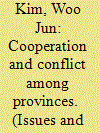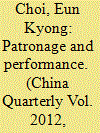|
|
|
Sort Order |
|
|
|
Items / Page
|
|
|
|
|
|
|
| Srl | Item |
| 1 |
ID:
161613


|
|
|
|
|
| Summary/Abstract |
Non-central governments in Canada have become increasingly active on the world stage, most notably in the Asia Pacific region. The scholarly works on Canada’s foreign policy in Asia tend to focus either on the federal government as the main actor, or on the “other diplomacies” of non-governmental actors; little attention has been paid to the increasing role of non-central governments in Asia. This article, therefore, contributes to the discussion by documenting and evaluating Canadian provinces’ international activities in the Asia Pacific. It also situates these activities within Canada’s foreign policy in the region, and assesses how important provinces have become in Canada–Asia relations. This paper first reviews the literature on non-central governments and foreign policy to expose the key forces pushing and pulling Canadian provinces to be increasingly active internationally. It then details the provinces’ international activities in Asia, and locates them within Canada’s foreign policy in the region.
|
|
|
|
|
|
|
|
|
|
|
|
|
|
|
|
| 2 |
ID:
124723


|
|
|
|
|
| Publication |
2013.
|
| Summary/Abstract |
Canadian provinces and territories have gained increasing relevance in matters of international trade over the last several decades. The possibility of a Canada-European Union Comprehensive Economic and Trade Agreement, however, marks the first time that sub-federal governments in Canada have been directly involved in specific areas of negotiations. The significance of this development, examined in this series of policy papers, can be organized under five overarching themes: 1) the negotiation, ratification, and implementation of foreign trade agreements; 2) the need to distinguish between process activity and actual policy outcomes; 3) the ongoing relevance of Canadian federalism; 4) the impact of non-governmental actors, especially civil society; and 5) the differing interpretations of academics, practitioners, business, and societal groups.
|
|
|
|
|
|
|
|
|
|
|
|
|
|
|
|
| 3 |
ID:
124726


|
|
|
|
|
| Publication |
2013.
|
| Summary/Abstract |
Why have the negotiations of a Comprehensive Economic and Trade Agreement (CETA) between Canada and the European Union taken so long? We argue that the delay is in good part the result of a weakly designed process for intergovernmental decision making: the role for provincial and territorial governments in international trade negotiations is still too limited and does not extend to final decisions about the text of any agreement. The limited role for provinces and the fact that there is no process that requires them to formally commit to an agreement leave open the real possibility that one or more provinces could choose not to fully implement any deal that is concluded. As a result, provinces possess negotiating leverage vis-à-vis Ottawa, thereby making it difficult for the federal government to agree to the trade-offs-which are of a geographical nature in CETA's case-that are necessary for reaching a positive agreement.
|
|
|
|
|
|
|
|
|
|
|
|
|
|
|
|
| 4 |
ID:
086013


|
|
|
|
|
| Publication |
2008.
|
| Summary/Abstract |
The development of cooperative relations between provinces in Northeast Asia has been reinforced by the global trend toward localization and decentralization. The relationship between China's three northeastern provinces and the Russian Far East may be seen as a mixture of cooperation and conflict.
|
|
|
|
|
|
|
|
|
|
|
|
|
|
|
|
| 5 |
ID:
143397


|
|
|
|
|
| Summary/Abstract |
Environmental pollution emissions have become an extremely serious problem in China that makes its rapid economic growth unsustainable. This paper estimates the energy and emission adjusted total factor productivity (TFP) and reveals the ecological economic transition by province in the light of their contributions to output. The results indicate that China's ecological development fluctuated before 1992, then turned to improve, and peaked between 1999 and 2002. Due to the reappearance of heavy industrialization, China's ecological development process has reversed course since the beginning of this century.
|
|
|
|
|
|
|
|
|
|
|
|
|
|
|
|
| 6 |
ID:
161260


|
|
|
|
|
| Summary/Abstract |
Most analyses of China's foreign and security policies treat China as a unitary actor, assuming a cohesive grand strategy articulated by Beijing. I challenge this conventional wisdom, showing how Chinese provinces can affect the formulation and implementation of foreign policy. This contributes to existing research on the role of subnational actors in China, which has focused on how they shape domestic and economic policies. Using Hainan and Yunnan as case studies, I identify three mechanisms of provincial influence – trailblazing, carpetbagging, and resisting – and illustrate them with examples of key provincial policies. This analysis provides a more nuanced argument than is commonly found in international relations for the motivations behind evolving and increasingly activist Chinese foreign policy. It also has important policy implications for understanding and responding to Chinese behaviour, in the South China Sea and beyond.
|
|
|
|
|
|
|
|
|
|
|
|
|
|
|
|
| 7 |
ID:
116488


|
|
|
|
|
| Publication |
2012.
|
| Summary/Abstract |
This paper attempts to estimate the impact of both factional ties and economic performance on the promotion of provincial Party secretaries and governors by analysing a person-year dataset of their career mobility for inclusive years 1989 to 2009. We found that for provincial Party secretaries whose promotion meant rising to a top national position, both factional ties and good economic performance increased their chance for promotion. On the other hand, for provincial governors whose promotion meant rising to a ministry-level position, only economic performance mattered for their promotion. Among provincial Party secretaries, the extent to which performance affected the likelihood of promotion was not different between factional members and non-members. This suggests that even factional members needed to show good performance to enhance the likelihood of their promotion.
|
|
|
|
|
|
|
|
|
|
|
|
|
|
|
|
| 8 |
ID:
132407


|
|
|
|
|
| Publication |
2014.
|
| Summary/Abstract |
This paper conducts an analysis of the socioeconomic determinants of Vietnam's cross-provincial variations in natural disaster vulnerability. The purpose is twofold: (i) to capture disaggregated vulnerability variations normally obscured by national statistics, thereby providing more nuanced insights into Vietnam's vulnerability to natural disasters; and (ii) to take advantage of the fact that the overall political system and key institutional structures to a large extent are constant across Vietnam's provinces, which makes the analysis a novel addition to the many disaster studies based on cross-national variations. The paper's analysis indicates that much of Vietnam's cross-provincial variations in natural disaster fatalities and economic costs can be explained by differences in key socioeconomic factors. High provincial rates of inequality, poverty and infant mortality, for instance, appear to drive up natural disaster fatalities. Local adaptation efforts should focus as much on these broader socioeconomic dimensions as they focus on the geophysical susceptibility to natural hazards of individual areas.
|
|
|
|
|
|
|
|
|
|
|
|
|
|
|
|
|
|
|
|
|